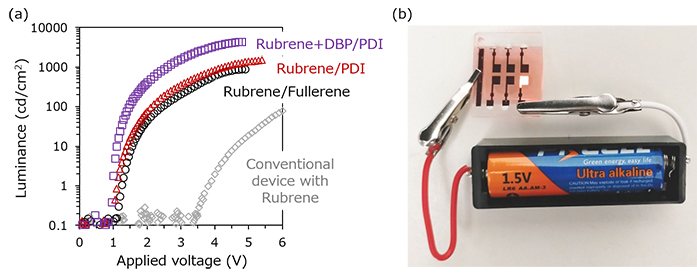A research group, including Assistant Professor Seiichiro Izawa, Professor Masahiro Hiramoto of the Department of Materials Molecular Science, Molecular Functions, Institute for Molecular Science, Associate Professor Masahiro Morimoto of the University of Toyama Faculty of Engineering, and Professor Shigeki Naka, successfully developed an organic light emitting diode (OLED) that can be driven by the world's lowest voltage and can emit light with the brightness of a display by connecting only one dry battery.
Organic electroluminescence (EL) is already on the market in smartphones and large screen TVs because it has high contrast, and the area of emission can be increased. However, it is necessary to reduce the device voltage to save energy.
In response to this need, the research group improved the efficiency by developing a process called upconversion at the interface between the two types of organic semiconductor materials responsible for light emission. The light-emitting process begins with the injected electrons and holes meeting and recombing at the interface between the electron transport layer and the hole transport/light-emitting layer. After that, the two triplet excited states generated by recombination collide with each other and emit light through a process called upconversion, which creates one high-energy singlet excited state.
In an organic EL device with a structure in which a normal light-emitting layer is sandwiched between electron/hole transport layers, light emission starts from approximately 3.5 V. However, in the organic EL element developed using this upconversion process, orange 608-nm (2.04 eV) light was emitted from 1 V or less, which is much smaller than the energy of the light. Furthermore, by using highly crystalline perylene diimide instead of fullerene in the electron transport layer, the interaction between organic molecules at the interface was controlled and deactivation was suppressed; by doping the light-emitting layer with a perylene phosphor to promote light emission, the light emission brightness was significantly improved.
Based on the results obtained, the luminous efficiency is approximately 70 times higher than that of organic EL devices using the conventional upconversion process. Due to this, it was possible to emit light with a brightness of 100 cd or more per square meter, which is the approximate brightness of a display, just by connecting one dry battery that has an electromotive force of about one-third of the conventional battery. According to Assistant Professor Izawa, “Currently, the voltage has been reduced with the orange emission color. In the future, we will aim to reduce the voltage of other emission colors such as green and blue and to conserve energy in commercially available organic EL devices by further improving efficiency.”

(b) Photograph of an OLED operated by a 1.5-V battery.
Provided by NINS/IMS
■ Upconversion: A process in which two excitons collide and one high-energy exciton is generated to increase the energy of light.
This article has been translated by JST with permission from The Science News Ltd.(https://sci-news.co.jp/). Unauthorized reproduction of the article and photographs is prohibited.




